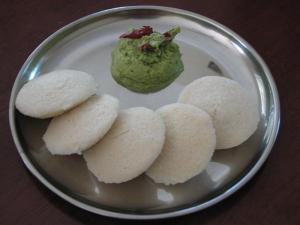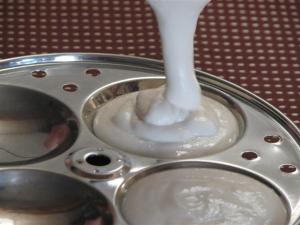
Idli needs no introduction to Indians. This signature breakfast item from South India has a devoted following all over India. It’s no exaggeration to say that Idlis are responsible for providing morning nutrition to about 200 million people everyday in the four southern states of India.
There are many ways to enjoy idlis. North Indians would swear by the idli-sambhar combo. I like them hot with a drizzle of ghee on top and some coconut chutney. Some people eat it with chutney powder. However you eat it, it’s good. Seriously, there is no breakfast like idli-chutney. It’s my favorite, followed closely by plain rava uppittu.
Idlis look like a very uncomplicated food. A batter made from rice and urad dal and then steamed into round, flat balls. No frying to be done, no spices to be added, no vegetables to be cut. As simple as this sounds, getting them soft and fluffy requires practice and attention to small details. There have been probably as many experiments conducted to get the idlis right as the number of stars in the sky but once you learn it, it becomes as easy as 1-2-3.
If you like idlis and would like to learn how to make them, I think this recipe will help. I have also given here the exact amount of water to be added to batter while grinding. This will help in getting the right consistency batter. The cup measure is as per the American standard (slightly smaller than a coffee mug)
1/2 cup Par boiled Rice (I use Ponni brand rice)
1/2 cup raw/regular rice
1/2 cup whole Urad Dal without the black skin
1/4 cup poha/puffed rice
1.5 tea spoon salt
Idli stand
A pot big and deep enough to hold the idli stand
Parboiled rice is rice that has been boiled in husk. It is more shiny and nutritious than regular rice and helps make idlis soft and spongy.

1. Soak the rice and urad dal separately in 4-5 cups of water for about 3 hours.
2. When ready to grind, add poha to the soaked rice.
3. Drain off all water from urad dal. Grind the urad dal until it is very soft and fluffy. You will need to add about 1 cup of water while grinding. When you feel the paste, it should have no grainy texture.
4. Drain off all water from rice. Grind rice along with poha/puffed rice in a grinder/mixer until almost smooth. You will need about 3/4 cup of water. The paste will feel just slightly coarse when you rub it between fingers.
5. Pour the ground rice and urad dal into a big pot and add 1.5 tea spoon of salt and mix the batter with your hand until salt is properly incorporated into the batter.
6. Cover the pot with a lid and put it away in a warm place for at least 12 hours. Here in California, I put it in oven and turn the oven light on. This works really well to ferment the batter. On a really cold day, I cover the pot with a big bath towel and then put it in the oven.
7. Once the batter is fermented, without stirring the batter, put a small ladleful of batter into each idli plate.
8. Bring 4-5 cups of water to boil in a pot big and deep enough to hold the idli stand. Once the water starts boiling, put the Idli stand in pot cover it with a lid and steam for about 7-8 minutes. Shut off the stove and remove the idli stand after 4-5 minutes.
9. Remove each plate from the idli stand, turn it upside down and let it run under water. Run a sharp edge spoon or spatula around the edge of the idli and scoop it out in a circular motion. Keep it in a container with a lid.

0 comments:
Post a Comment